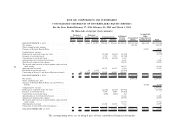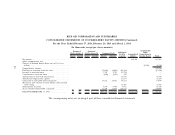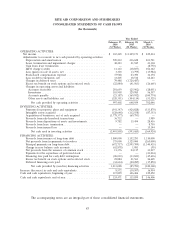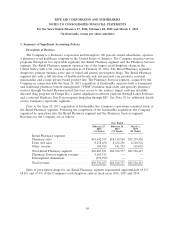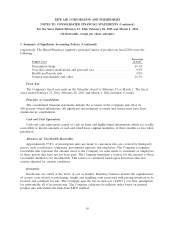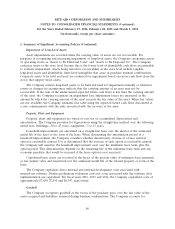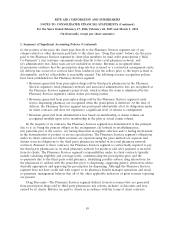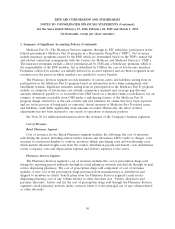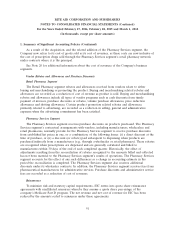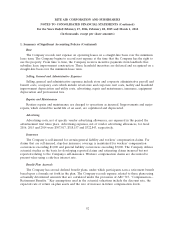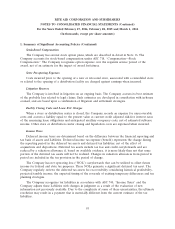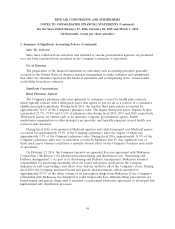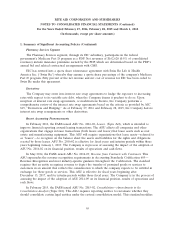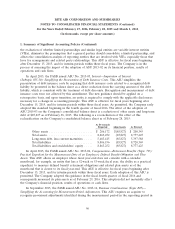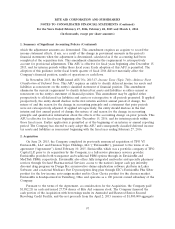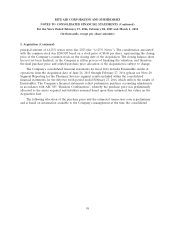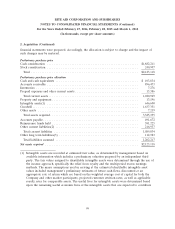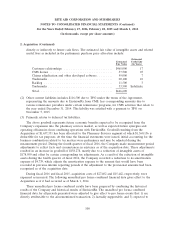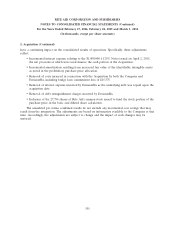Rite Aid 2016 Annual Report Download - page 91
Download and view the complete annual report
Please find page 91 of the 2016 Rite Aid annual report below. You can navigate through the pages in the report by either clicking on the pages listed below, or by using the keyword search tool below to find specific information within the annual report.RITE AID CORPORATION AND SUBSIDIARIES
NOTES TO CONSOLIDATED FINANCIAL STATEMENTS (Continued)
For the Years Ended February 27, 2016, February 28, 2015 and March 1, 2014
(In thousands, except per share amounts)
1. Summary of Significant Accounting Policies (Continued)
As a result of the Acquisition, and the related addition of the Pharmacy Services segment, the
Company now refers to its cost of goods sold as its cost of revenues, as these costs are now inclusive of
the cost of prescription drugs sold through the Pharmacy Services segment’s retail pharmacy network
under contracts where it is the principal.
See Note 20 for additional information about the cost of revenues of the Company’s business
segments.
Vendor Rebates and Allowances and Purchase Discounts
Retail Pharmacy Segment
The Retail Pharmacy segment rebates and allowances received from vendors relate to either
buying and merchandising or promoting the product. Buying and merchandising related rebates and
allowances are recorded as a reduction of cost of revenue as product is sold. Buying and merchandising
rebates and allowances include all types of vendor programs such as cash discounts from timely
payment of invoices, purchase discounts or rebates, volume purchase allowances, price reduction
allowances and slotting allowances. Certain product promotion related rebates and allowances,
primarily related to advertising, are recorded as a reduction in selling, general and administrative
expenses when the advertising commitment has been satisfied.
Pharmacy Services Segment
The Pharmacy Services segment receives purchase discounts on products purchased. The Pharmacy
Services segment’s contractual arrangements with vendors, including manufacturers, wholesalers and
retail pharmacies, normally provide for the Pharmacy Services segment to receive purchase discounts
from established list prices in one, or a combination, of the following forms: (i) a direct discount at the
time of purchase, or (ii) a discount (or rebate) paid subsequent to dispensing when products are
purchased indirectly from a manufacturer (e.g., through a wholesaler or retail pharmacy). These rebates
are recognized when prescriptions are dispensed and are generally calculated and billed to
manufacturers within 30 days of the end of each completed quarter. Historically, the effect of
adjustments resulting from the reconciliation of rebates recognized to the amounts billed and collected
has not been material to the Pharmacy Services segment’s results of operations. The Pharmacy Services
segment accounts for the effect of any such differences as a change in accounting estimate in the
period the reconciliation is completed. The Pharmacy Services segment also receives additional
discounts under its wholesaler contracts. In addition, the Pharmacy Services segment receives fees from
pharmaceutical manufacturers for administrative services. Purchase discounts and administrative service
fees are recorded as a reduction of cost of revenues.
Reinsurance
To minimize risk and statutory capital requirements, EIC enters into quota share reinsurance
agreements with unaffiliated reinsurers whereby they assume a quota share percentage of the
company’s Medicare Part D program. The net revenue and net cost of revenue for EIC has been
reduced by the amounts ceded to reinsurers under these agreements.
91


